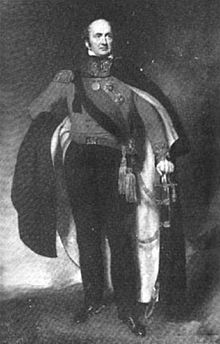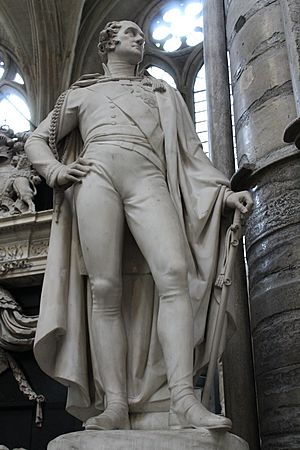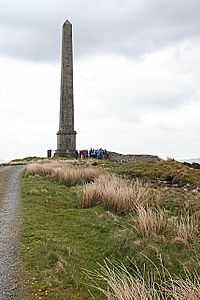John Malcolm facts for kids
Quick facts for kids
Sir John Malcolm
|
|
|---|---|
 |
|
| Governor of Bombay | |
| In office 1 November 1827 – 1 December 1830 |
|
| Monarch | George IV William IV |
| Governor-General | The Earl Amherst Lord William Bentinck |
| Preceded by | Mountstuart Elphinstone |
| Succeeded by | The Earl of Clare |
| Personal details | |
| Born | 2 May 1769 Burnfoot, Dumfriesshire, Scotland |
| Died | 30 May 1833 (aged 64) London, England |
| Nationality | British |
| Occupation | Soldier, Statesman, Historian |
| Military service | |
| Allegiance | |
| Branch/service | Madras Army |
| Years of service | 1782–1833 |
| Rank | Major-General |
| Battles/wars | Third Anglo-Mysore War Fourth Anglo-Mysore War Battle of Mahidpur |
Major-General Sir John Malcolm GCB, KLS (born May 2, 1769 – died May 30, 1833) was an important Scottish soldier, diplomat, and historian. He worked for the East India Company, which was a powerful British trading company. He became a well-known statesman, meaning he was skilled in government and diplomacy. Sir John Malcolm played a big role in British India during his time.
Contents
Early Life of Sir John Malcolm
John Malcolm was born in 1769 in Eskdale, Scotland. He was one of seventeen children in his family. His father, George Malcolm, was a farmer who didn't have much money.
At just thirteen years old, John left his home and family. He went to India to work for the East India Company. People there gave him the nickname 'Boy Malcolm' because he was so young.
Sir John Malcolm's Career
Starting His Career in India
In 1783, John Malcolm arrived in Madras (now Chennai), India. He started as an ensign, which is a low-ranking officer, in the East India Company's army. He served as a soldier for eleven years.
After that, he spent a year in Britain to get his health back. He returned to India in 1795. This time, he was a Military Secretary to General Sir Alured Clarke. On the way, he helped capture the Cape of Good Hope in South Africa.
Diplomatic Missions and Wars
During the Anglo-Mysore wars in 1799, John Malcolm worked with the Hyderabad army. Later, he helped set up the new government in Mysore as a secretary. That same year, the Governor-General, Lord Mornington, chose him for an important diplomatic mission to Iran.
After returning in 1801, he became the Governor-General's private secretary in Calcutta. In the Anglo-Maratha war (1803–1805), he joined Sir Arthur Wellesley (who later became the Duke of Wellington). Malcolm was the Governor-General's representative, and the two men became lifelong friends.
In 1804, he became the British Resident in Mysore. A Resident was a British official who lived in an Indian state to advise its ruler. He also served in northern India with General Lake in 1805-1806.
In 1808, Governor-General Lord Minto sent Malcolm on a second mission to Iran. However, France had a strong influence in Tehran at that time, and Malcolm was not successful. Later, the British government decided to handle relations with Iran directly from London.
Writing and Governing Bombay
In 1812, Malcolm went back to Britain for five years. He spent much of this time writing books. In 1815, he finished his book History of Iran. This was the first English history book about Iran that used Iranian sources. For this work, he received an honorary degree from the University of Oxford.
He returned to India in 1817. He helped with talks that led to the third (and last) Anglo-Maratha war. He also led Company troops to victory against Maharajah Malhar Rao Holkar II at the Battle of Mahidpur in December 1817.
In 1818, Malcolm was put in charge of Central India. For four years, he gathered information about the region. He sent a report to Calcutta, which was then printed by the government.
Governor of Bombay's Work
In 1827, Sir John Malcolm was appointed Governor of Bombay. His time as governor was mostly successful. He worked to promote education for Indians. He also helped train Indians for higher government jobs. He was a pioneer in these efforts, along with his predecessor, Mountstuart Elphinstone. He also served as president of the Literary Society of Bombay.
Later Life and Legacy
In 1831, Malcolm finally returned to Britain. He quickly became a Member of Parliament for Launceston. He supported his friend, the Duke of Wellington, against the Reform Bill. This bill aimed to change how Parliament worked.
His last public act was a speech in April 1833. He convinced the shareholders of the East India Company to accept the government's terms. Soon after, he had a stroke and died on May 30, 1833. He was buried in St James's Church, Piccadilly.
There is a marble statue of Malcolm in Westminster Abbey in London. There is also a statue of him in the town hall in Bombay (now Mumbai), India. A tall monument celebrating his achievements stands on Whita Hill in Scotland.
Family Life
In 1807, John Malcolm married Isabella Charlotte in Mysore, India. She was the daughter of General Sir Alexander Campbell. They had five children together, including George Alexander Malcolm.
Malcolm's Important Ideas
Sir John Malcolm, along with his friends Mountstuart Elphinstone and Sir Thomas Munro, helped shape early British rule in India. They had four main ideas:
- India should be ruled for the benefit of the East India Company, but also for Indians. This meant no British settlers would move there permanently.
- They preferred "indirect rule." This meant leaving existing Indian rulers in charge whenever possible. They tried to avoid changing traditional ways of government, religion, and social life.
- Malcolm helped develop the role of the District Officer. These were powerful administrators who managed areas with very little military force.
- Malcolm supported a "forward" foreign policy. This meant having diplomatic talks with nearby countries like Iran, Afghanistan, and Central Asia.
People He Inspired
Malcolm was a mentor to many famous Anglo-Indian statesmen. These were British officials who served in India. Some of them include Henry Pottinger, Charles Metcalfe, Alexander Burnes, and Henry Rawlinson.
Books by Sir John Malcolm
Sir John Malcolm wrote nine books and a book of poetry. Here are some of his most important works:
- Sketch of the Sikhs, 1812
- Sketch of the Political History of India, 1811
- Disturbances in the Madras Army in 1809, 1812
- The History of Persia, 1815
- A Memoir of Central India, 1823
- The Political History of India, 1826
- Sketches of Persia, 1827 (This book was written by one of his companions, not Malcolm himself, but it describes his mission to Iran.)
- The Government of India, 1833
- The Life of Robert, Lord Clive, 1836 (published after his death)



